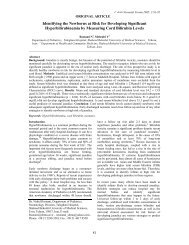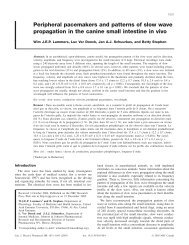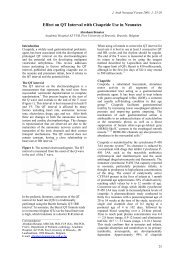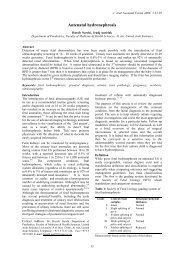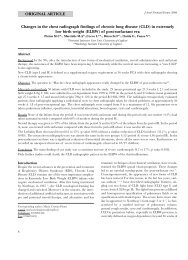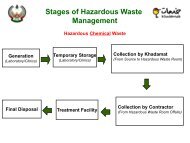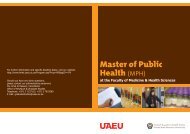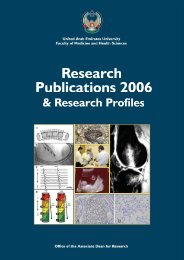Research Profile - College of Medicine and Health Science - United ...
Research Profile - College of Medicine and Health Science - United ...
Research Profile - College of Medicine and Health Science - United ...
Create successful ePaper yourself
Turn your PDF publications into a flip-book with our unique Google optimized e-Paper software.
Department <strong>of</strong> Medical Microbiology & Immunology<br />
effective in inhibiting the growth <strong>of</strong> malignant<br />
melanoma. They have also shown that this form<br />
<strong>of</strong> immunotherapy is active when given orally,<br />
which is <strong>of</strong> significant benefit as it decreases<br />
the toxicity <strong>of</strong>ten associated with systemic<br />
cytokine therapies. The exact mechanism(s) by<br />
which recombinant Salmonella strains inhibit<br />
tumor growth are not yet fully known. However,<br />
evidence to date indicates that the process is<br />
independent <strong>of</strong> T lymphocytes but is dependent<br />
on Toll-like receptors (TLRs), implying a critical<br />
role for the innate immune response in the antitumor<br />
effect. A report describing the<br />
experimental model system <strong>and</strong> findings was<br />
published recently in Clinical Immunology<br />
130:89-97, 2009 (Figure 1).<br />
Pr<strong>of</strong>essor Senarath Dissanayake - Dr.<br />
Dissanayake’s research interests are in parasite<br />
glycan immunobiology <strong>and</strong> tuberculosis.<br />
Current emphasis in glycan immunobiology is<br />
on molecular characterization <strong>of</strong> parasite<br />
glycans with respect to upregulation <strong>of</strong> the<br />
transcription factor NF-kB <strong>and</strong> signaling effects<br />
<strong>and</strong> mechanisms leading to IFN-g <strong>and</strong> IL-6<br />
expression (Figure 2). With respect to IFN-Á,<br />
one specific area <strong>of</strong> research is negative<br />
regulation <strong>of</strong> TLR signaling. Long-term objective<br />
is development <strong>of</strong> synthetic immunoadjuvants<br />
with defined Th-1 <strong>and</strong> Th-2 immunomodulatory<br />
properties. Based on the previous finding that<br />
terminal ‚-(1-4) galactose residues on GlcNAc<br />
backbones is an epitope regulating IFN-Á (a Th-<br />
1 cytokine), a panel <strong>of</strong> synthetic glycans is being<br />
investigated for further development as<br />
adjuvants. In tuberculosis research,<br />
epidemiological studies are being carried out to<br />
determine the source(s) <strong>of</strong> infection, patterns <strong>of</strong><br />
transmission <strong>and</strong> the possible causes <strong>of</strong> likely reactivation<br />
in long-term residents <strong>of</strong> UAE.<br />
Figure 1: Treatment <strong>of</strong> B16 melanoma-bearing mice with<br />
multiple low doses <strong>of</strong> IL2-expressing Salmonella<br />
typhimurium (strain GIDIL2) prolongs host survival <strong>and</strong><br />
inhibits tumor growth. Tumor-bearing mice were given three<br />
i.p. injections at the indicated days (arrows) <strong>of</strong> either saline<br />
or low doses (103-104 per mouse) <strong>of</strong> the GIDIL2 strain. Tumor<br />
volume (A) <strong>and</strong> animal survival (B) were then followed over<br />
the next 60 day s. Each data point represents the mean ±<br />
SEM <strong>of</strong> 8–10 mice per group. Asterisks denote statistically<br />
significant differences from saline control group (***, p <<br />
0.001; **, p




